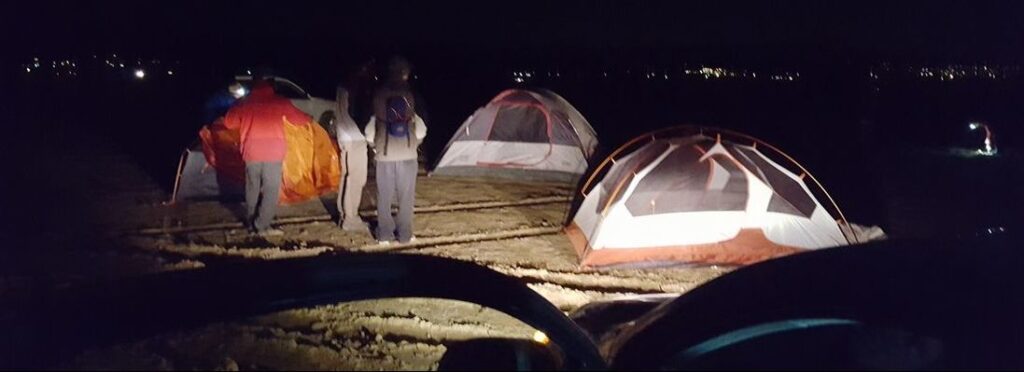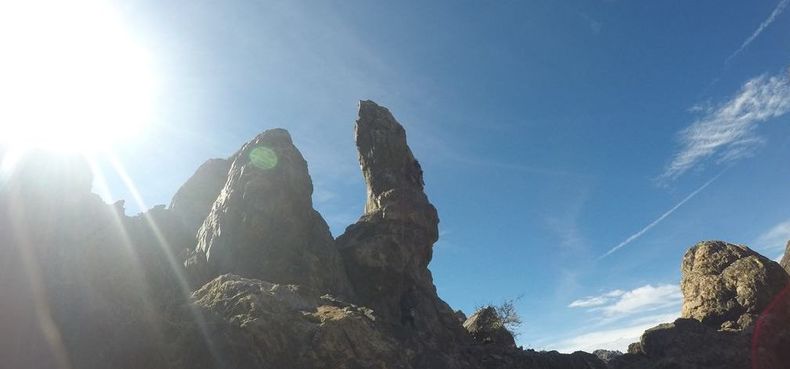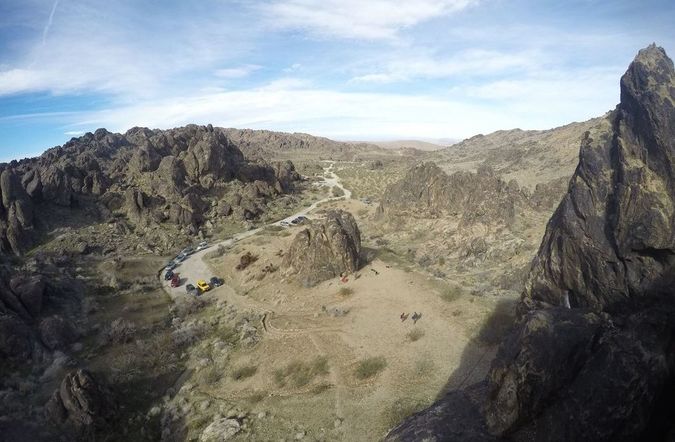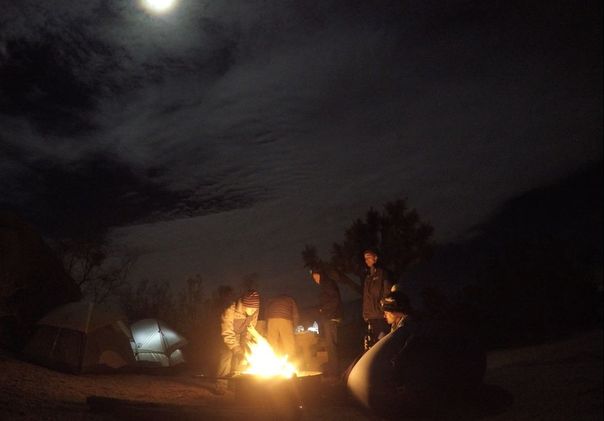It’s time for a well overdue trip report that all of us were too lazy to write about!
During the last week of winter break, a good number of us went out west in search of good climbing, less than freezing rocks, lots of good food, and maybe a chance to get lucky.

Our group comprised mainly of two groups, trad (local climbing legend Alex James and co), and sport (everyone else who wasn’t worthy enough for our local climbing legend). And Red Rock Canyon National Conservation Area, or Red Rocks for short, boasts quality trad, sport and multi pitch routes in a dry and arid desert (average of 4 days of rain a month), which was perfect for our group. With over two thousand routes just a few miles off Las Vegas Boulevard aka The Strip, this was the go to crag for our winter break.
Most of us flew into Las Vegas airport, except my MVP Ansel Higgs and gang (Eric, Dylan and Amanda) who decided that it wouldn’t be enough of a challenge unless you drove across continental US in the middle of winter (it was rad). Some groups of us arrived a few days earlier and got some climbing in at Red Rocks, while Kyle, Kirsten, Noah and I arrived on Saturday. Kyle rented a sweet SUV, and even with that amount of space, we barely fit all 4 of us with luggage, camping and climbing gear in, so in case you’re considering fitting 5 into a vehicle, I do not recommend that.

So now it’s time for some fun facts:
- The sandstone formations at Red Rocks are, well, red (Cause of iron oxidization. Fuck yea geology)
- Red Rocks gets on average 4 days of rain a month
- The sandstone in Red Rocks are fragile and are easily damaged when wet, and remain unclimbable for 2-3 days
- Apparently the 4 days of rain a month all happened during the week of our trip.
So when our car was finally ready to go, we found out that we would not be able to climb at Red Rocks for the next few days. With the rain derailing our plans, our trip took a detour down South towards Joshua Tree National Park (JTree). We needed a place to camp out, and the group ahead of us found a Bureau of Land Management (BLM) campsite, which was free.
The catch? It’s in the middle of a dried up lake.
There are quite literally no roads there, so driving in at near 2am and shining our headlights in hopes of finding our group was a huge pain in the ass. After half an hour of aimless wandering at other groups of parked cars, watching the GPS jump around, and leaving tire tracks over half the damn lake, we found our group and finally caught some sleep.


Next morning, after hugging each other in acknowledgement that our friends are in fact alive, our group debated on what to do for coming days. Joshua Tree had a lot more trad and bouldering, and about half of us were there mainly for sport. So by the power of Mountain Project (go download it), we found this place called New Jack City about an hour from JTree, and our group split from there.
Now for the good stuff. New Jack City (officially known as Sawtooth Canyon) is the beautiful gem hidden in the middle of nowhere in Southern California with some 300 sport routes. The metamorphic rock looks gorgeous and while there are a few sketchy routes with choss (loose rock), most of the holds are solid and generally safe. Routes are well bolted and easy to find, even without a guidebook we got around pretty well with Mountain Project. Unfortunately because we didn’t have a guidebook, I did not keep track of which climbs I did, and we kinda just went ahead with whatever grade we were told the climbs were as long as they were within our abilities. On that note, gradings there are close to Jackson Falls, not too tough, but definitely not soft.
The crag comprised mainly a 5.10 and 5.11 climbs, so lucky for me, I managed to bag a few mid 10s which I was comfortable leading. That said, there are some good 5.7-9 climbs too, with the only climb I remember being Crooked Dick Spire (5.9), or as I like to call it, Poop Rock. There are also a few two pitch climbs, one of which I did with Ansel as our first sport multipitch. Unfortunately, it is chossy as hell, hard to find, and very exposed (lots of wind), coupled with some technical difficulties, ended up not being a great climb. But still if you’re looking to do your first multi pitch, there are options in New Jack City.


Other great things about New Jack City, camping is free, with vault toilets, a pavilion and fire pit for each, and while there is no running water, the town of Barstow is only a 30 minute drive North on a straight road from New Jack, where you can find a Walmart, gas stations and restaurants.
Did I forget to mention that the crag is 100 feet from the car park?
That was literally my favorite part about New Jack City. It was so compact and accessible, with a bunch of climbs just a five minute walk from the campsite. I felt like I was in this playground that I never got to explore as a child, just that this was a playground for climber which was even better.
The sport group spent two days at New Jack City. The first night, it was forecast to rain so only my car camped at New Jack City while the others went back to the BLM lake. But well it rained at both places (in fact it hit them harder in the middle of a freaking dried up lake with no shelter), and they ended up coming back to New Jack City, so I guess we won that night. Also, we had breakfast at this lovely diner chain called Black Bear Diner, which was a little pricey, but had massive portions and was absolutely delicious so I highly recommend it.


After two days in New Jack City, we heard that there are some sport climbs in JTree so we headed there to regroup. Camping at JTree was apparently full, paid campsites nearby were expensive, and we were sick of staying in a dried lake. So we got two motel rooms instead (9 Palms Inn), which allowed for a good night of drinking and ice cream. Also, showers. It’s nice to be clean once in a while.
Joshua Tree National Park has over a thousand boulder problems and much more trad routes, known to be notoriously sandbagged (under graded). But with no crash mats we had to make do with whatever sport routes we had. Our group split into two, one group followed the trad group by top roping their routes (I only joined for one day, which I didn’t remember much of), and the other group sport climbed in this place called Siberia.
The approach to Siberia was flat but about 2 miles long along a well-marked path called the Boy Scout’s Trail. Getting near the crag was not an issue, getting to the actual climbs to find the damn routes was near impossible without a guidebook, because the main path kind of disappears and it becomes easy to follow a ‘stray path’ that guides you away.
When we first arrived at the rocks, we saw a few routes with the first bolt unreasonably high up (I swear some first bolts were at least 25 feet up, not a difficult route, but not some simple scramble up). Finally after Kyle went exploring a little we found the right place with a couple of good climbs. They were mostly 5.9-10a, with some questionable flakes, high first bolts, and very sketchy scrambles to the base of each route. But they were good climbs, with my second (or first proper) multi pitch Dos Chi Chis (5.10a, 2 pitches) that I did with Kirsten, a slab climb that that was very exposed (Noah apparently got blown off the route, literally), but very enjoyable.



Getting out of Siberia however, was much less enjoyable. On the first evening, Kyle, Eric, Noah and I had our little desert adventure getting lost, following a bunch of paths and misidentifying landmarks which guided us off track (though I have to say it was quite a scenic hike out in the moonlight). Thankfully Kyle had GPS on his offline maps which allowed us to find the trail after an hour of wandering. So go download offline maps, your life could depend on it.
Another highlight of our trip to Jtree was The Chasm of Doom, a mini ‘cave system’ of sorts that involves lots of scrambling which occasionally gets sketchy, as well as squeezing through cracks and up chimneys. It starts near the Real Hidden Valley loop trail, but honestly I’m not too sure where it really is, you can search online for more details. In fact we may not have done the ‘actual’ trail cause it’s supposedly a secret route but we did what we could. The best part of The Chasm of Doom was that we did it during a full moon, so we barely even used our headlights, relying on the bit of moonlight seeping through the cracks. Highly recommend doing this.
Other things to note about this part of the trip, JTree is a National Park, so you need a weekly pass ($25) or an annual pass (~$80) for each car. Camping in the park is not easy as campsites fill up fast, but we found a site at Jumbo Rocks campground, which was far from the crags we were headed for, but still a nice campground. Also, JTree has vault toilets around, but no running water so remember to stock up. Food wise, there’s a great pizza place called Pie for the People in the town just North (Twentynine Palms). Oh and the rocks in Jtree are quartz monzonite, an igneous rock which from far looks smooth, but up close it is essentially sandpaper embedded with crystals. In other words, don’t fall on the rock. It’s incredibly grippy, but it will grate off any skin you have if you grind yourself against it on a fall.

After three days at Jtree, our group decided to head to find out one more sports crag for our last day of climbing, this time in Phoenix, Arizona. The place we went to was called Camelback Mountain, and it is smack in the middle of the city. Because of that, we couldn’t find a campsite, and settled for a Motel 6 instead.
Camelback Mountain is more of a park, being very established in terms of its walking path, with a nice carpark at the base and a toilet with running water there. Getting to the crag was a little tricky. It’s very close to the carpark and you don’t have to run too far off. Mountain Project has more details on it. But basically there are two walls. Headwall is the base with 10 routes, and Gargoyle Wall is ABOVE Headwall. Yes, you have to climb up some route first before you arrive at Gargoyle Wall, which was why we got quite lost in the process.
All of us paired up and got on some sort of a multi pitch climb. I was with Kyle heading up this unnamed route, Unknown (5.10a, 3 pitches). First pitch was tricky, because the belay ledge was very far right, and I missed it which required some down climbing and quickdraw retrieval. Second pitch was where the trouble began. Kyle got pretty far up, and I was nearing the end of my payable rope. We tried shouting for him but the wind was strong and we couldn’t hear each other. Eventually Eric and Amanda who were climbing beside up got high up enough and he told us he was at the anchors, so I unclipped and started climbing too. Eventually I got up, met Kyle at the anchor and learnt that
- This was a 3 pitch climb, not 2 that we initially thought it was (Kyle missed the inconspicuous second belay ledge)
- Kyle did not reach the anchor yet, but told me that he was so that I would start climbing, which would give him the slack that he needed to reach the anchor
- Simul-climbing is a thing
All was well, and we were safely up the top of Camelback Mountain with a panoramic view of Phoenix. Next came the problem of finding the rappel site back down. We had to find Pedrick’s Chimney, and that took a long time and involved passing by a huge ass cactus, but we all got down safely. Important things to note about Camelback Mountain is that there’s a beehive and people have apparently gotten stung (people have even died cause of it), but follow the guide and stay clear of the hive. Helps that we went in winter so we didn’t see any. Another thing is that this place should really be called Choss Mountain cause there are many pieces of loose rock, some the size of a fist, and very dangerous. Bring a helmet and remember to shout ‘Rock’ if debris starts falling down the wall.


With the sun setting in Arizona, we headed back to Vegas and caught our flights out of Sin City, marking the end of our climbing trip. Our grand plans for the week in Vegas never happened (I never got to eat my ramen), but I’m kind of glad we ended up straying so far from our original plans. The highlight for me was definitely New Jack City, which I would never have found had we not detoured all the way down to Southern California.
Special shoutout to Kyle for coordinating and taking charge of things with our car, always looking out for us, to Noah and Kirsten for being awesome car buddies, and Eric and Amanda for helping me get sketchy van back home from Oklahoma City. It was a fantastic trip, and I can’t wait to get back outdoors for more climbing.